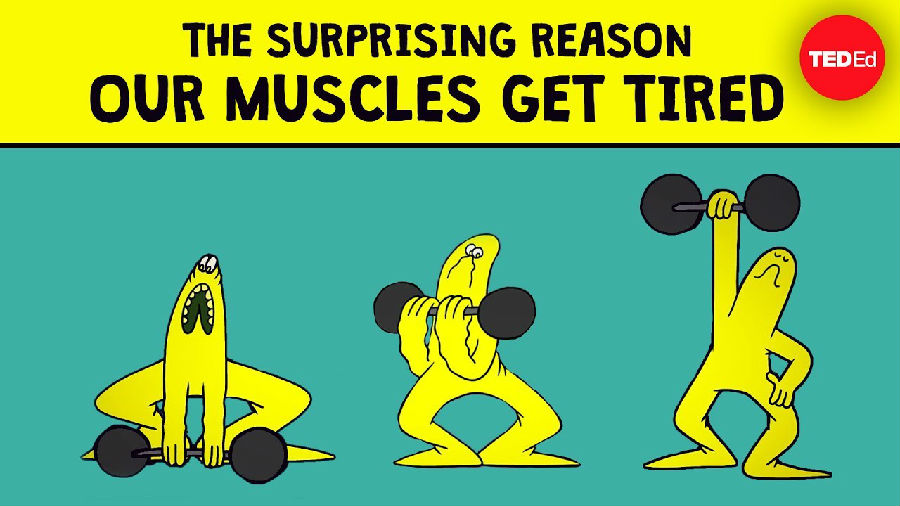You're lifting weights. The first time feels easy, but each lift takes more and more effort until you can't continue.
当你举重的时候,第一次感觉很容易,但一次比一次费劲,直到你再也无法继续。
Inside your arms, the muscles responsible for the lifting have become unable to contract.
在你的胳膊里,负责举重的肌肉已经无法收缩。
Why do our muscles get fatigued?
为什么我们的肌肉会感到疲劳?
We often blame lactic acid or running out of energy, but these factors alone don't account for muscle fatigue.
我们常把原因归咎于乳酸或者能量耗尽,但这些并不是肌肉疲劳的全部原因。
There's another major contributor: the muscle's ability to respond to signals from the brain.
还有另外一个主要因素:肌肉对大脑信号做出反应的能力。
To understand the roots of muscle fatigue, it helps to know how a muscle contracts in response to a signal from a nerve.
为了理解肌肉疲劳的根本原因,首先要了解在接到神经信号后,肌肉是如何收缩的。
These signals travel from the brain to the muscles in a fraction of a second via long, thin cells called motor neurons.
这些信号在不到一秒钟的时间内,通过细长的运动神经元,从大脑传递至肌肉。
The motor neuron and the muscle cell are separated by a tiny gap, and the exchange of particles across this gap enables the contraction.
运动神经元和肌肉细胞被很小的间隙隔开,粒子通过这个间隙交换,从而实现肌肉收缩。
On one side of the gap, the motor neuron contains a neurotransmitter called acetylcholine.
在间隙的一侧,运动神经元含有一种叫做乙酰胆碱的神经递质。
On the other side, charged particles, or ions, line the muscle cell's membrane: potassium on the inside, and sodium on the outside.
在间隙的另一侧,带电粒子,或者离子,排列在肌肉细胞膜上:钾离子在内,钠离子在外。
In response to a signal from the brain, the motor neuron releases acetylcholine, which triggers pores on the muscle cell membrane to open.
接收到大脑传来的信号后,运动神经元释放乙酰胆碱,使肌肉细胞膜上的孔隙张开。
Sodium flows in, and potassium flows out.
钠离子流入,钾离子流出。
The flux of these charged particles is a crucial step for muscle contraction:
这些带电粒子的流动是肌肉收缩至关重要的一步:
the change in charge creates an electrical signal called an action potential that spreads through the muscle cell,
电荷的变化产生了一种叫作动作电位的电信号,这种电信号通过肌肉细胞传播,
stimulating the release of calcium that's stored inside it.
刺激储存在其中的钙离子的释放。
This flood of calcium causes the muscle to contract
大量地钙离子将使肌肉收缩,
by enabling proteins buried in the muscle fibers to lock together and ratchet towards each other, pulling the muscle tight.
通过让埋藏在肌肉纤维里的蛋白质锁在一起,相互拉紧,从而使肌肉拉紧。
The energy used to power the contraction comes from a molecule called ATP.
肌肉收缩的能量来自一种名为ATP酶的分子。

ATP also helps pump the ions back across the membrane afterward, resetting the balance of sodium and potassium on either side.
之后,ATP酶也有助于将离子泵回到膜上,重新恢复钾钠离子在两侧的平衡。
This whole process repeats every time a muscle contracts.
每次肌肉收缩都要重复这个过程。
With each contraction, energy in the form of ATP gets used up, waste products like lactic acid are generated,
肌肉每收缩一次,ATP酶形式的能量将被用尽,产生乳酸等废物,
and some ions drift away from the muscle's cell membrane, leaving a smaller and smaller group behind.
部分离子从肌肉细胞膜上流失,残留的离子越来越少。
Though muscle cells use up ATP as they contract repeatedly, they are always making more,
尽管肌肉细胞反复收缩会耗尽ATP酶,但肌肉细胞一直不断产生新的ATP酶,
so most of the time even heavily fatigued muscles still have not depleted this energy source.
所以大部分情况下,即便是非常疲累的肌肉也不会完全耗尽ATP酶。
And though many waste products are acidic, fatigued muscles still maintain pH within normal limits,
即便产生的很多废物都是酸性的,但疲劳的肌肉始终把酸碱度保持在正常范围,
indicating that the tissue is effectively clearing these wastes.
这说明组织正在高效地清理这些废物。
But eventually, over the course of repeated contractions
但是最终,随着肌肉反复收缩,
there may not be sufficient concentrations of potassium, sodium or calcium ions immediately available near the muscle cell membrane to reset the system properly.
肌肉细胞膜附近可用的钾、钠、钙离子的浓度,可能不足以使整个系统恢复正常。
So even if the brain sends a signal, the muscle cell can't generate the action potential necessary to contract.
所以即便大脑传来了信号,肌肉细胞仍然因不能产生动作电位而无法收缩。
Even when ions like sodium, potassium or calcium are depleted in or around the muscle cell, these ions are plentiful elsewhere in the body.
即使肌肉细胞内部及其周围的钾、钠、钙离子被耗光,在身体的其他部位这些离子仍然十分丰富。
With a little time, they will flow back to the areas where they're needed, sometimes with the help of active sodium and potassium pumps.
只需要一点点时间,它们就可以流回到需要的地方,有时这个过程需要活性钠钾泵的帮助。
So if you pause and rest, muscle fatigue will subside as these ions replenish throughout the muscle.
所以如果你停下来歇一会儿的话,当这些离子补充至整个肌肉,肌肉疲劳会消退。
The more regularly you exercise, the longer it takes for muscle fatigue to set in each time.
锻炼越规律,肌肉达到疲劳状态的时间便会越慢。
That's because the stronger you are,
这是因为你越是强壮,
the fewer times this cycle of nerve signal from the brain to contraction in the muscle has to be repeated to lift a certain amount of weight.
举重时,神经信号从大脑至肌肉收缩的循环所需重复的次数就越少。
Fewer cycles means slower ion depletion, so as your physical fitness improves, you can exercise for longer at the same intensity.
次数越少意味着离子消耗越慢,所以随着身体素质的提升,同样强度的运动可以持续更长时间。
Many muscles grow with exercise, and larger muscles also have bigger stores of ATP and a higher capacity to clear waste,
很多肌肉在锻炼中增长,而越大的肌肉拥有越大的ATP酶储备,更强的废物清洁能力,
pushing fatigue even farther into the future.
使疲劳感的出现越来越晚。












